Healthcare Project: Establishing a Hospital with Basic Facilities
VerifiedAdded on 2023/06/12
|18
|5101
|243
Project
AI Summary
This project details the establishment of a hospital with all basic facilities in Saudi Arabia, envisioned as a benchmark for quality healthcare services. The project aims to transform healthcare by focusing on quality services, efficient leadership, and continuous learning for healthcare professionals. Key objectives include improving healthcare quality, setting a model for health service delivery, revolutionizing health sciences education, and maintaining high ethical standards. The hospital will offer comprehensive services, including emergency care, in-patient and out-patient services, qualified staff, a well-stocked pharmacy, and a fully equipped laboratory. The project seeks to address challenges such as mismanagement, incompetent staff, and insufficient health professionals by adopting a non-profit motive to ensure affordable and accessible healthcare. Strategies include promoting education and diversity among health workers, involving community health workers, emphasizing preventive care through health promotion theories, and providing palliative care for the elderly and those with chronic conditions. This initiative aims to improve the overall health and quality of life for the people of Saudi Arabia.

Hospital 1
A HOSPITAL WITH ALL BASIC FACILITIES
by
Course
Tutor
University
City and State
Date
A HOSPITAL WITH ALL BASIC FACILITIES
by
Course
Tutor
University
City and State
Date
Paraphrase This Document
Need a fresh take? Get an instant paraphrase of this document with our AI Paraphraser
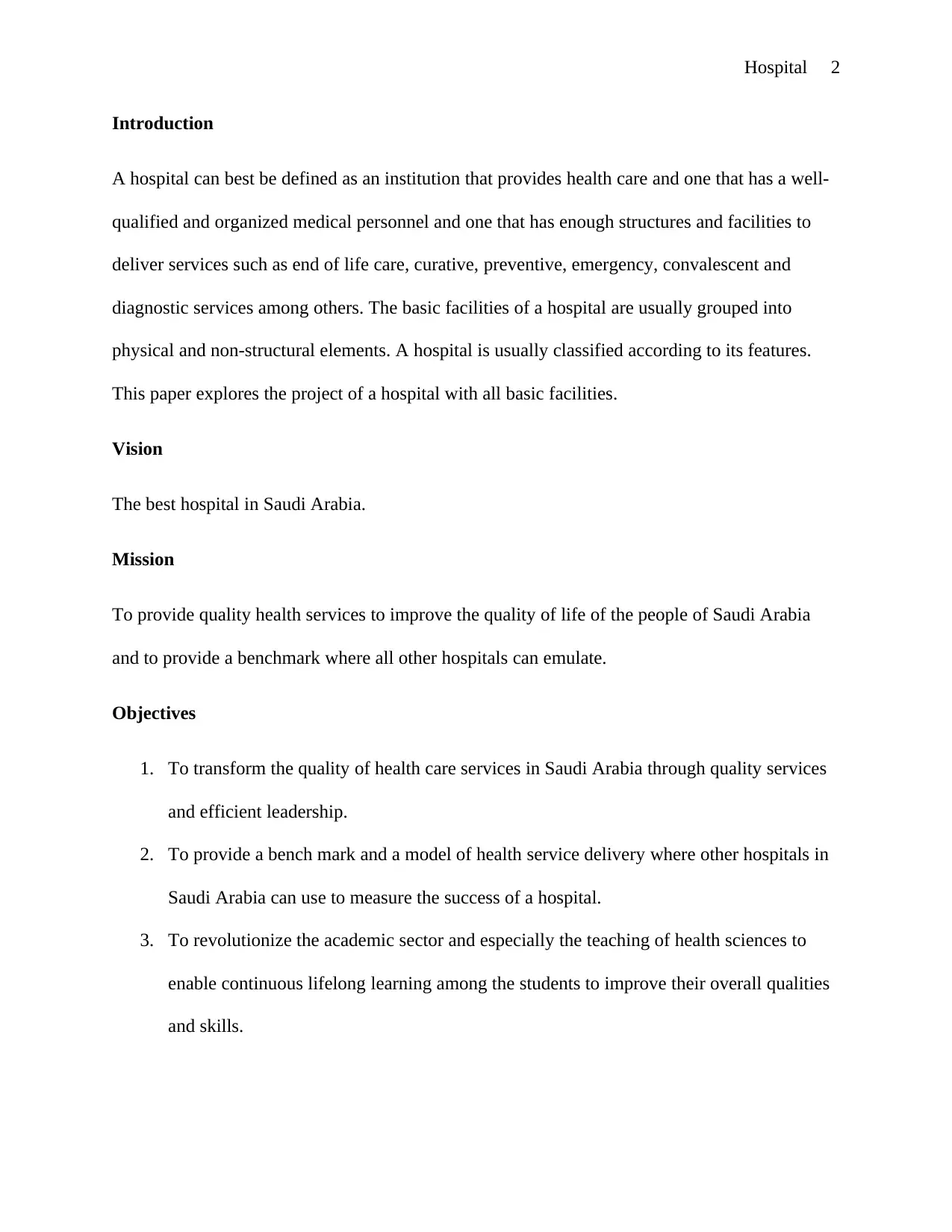
Hospital 2
Introduction
A hospital can best be defined as an institution that provides health care and one that has a well-
qualified and organized medical personnel and one that has enough structures and facilities to
deliver services such as end of life care, curative, preventive, emergency, convalescent and
diagnostic services among others. The basic facilities of a hospital are usually grouped into
physical and non-structural elements. A hospital is usually classified according to its features.
This paper explores the project of a hospital with all basic facilities.
Vision
The best hospital in Saudi Arabia.
Mission
To provide quality health services to improve the quality of life of the people of Saudi Arabia
and to provide a benchmark where all other hospitals can emulate.
Objectives
1. To transform the quality of health care services in Saudi Arabia through quality services
and efficient leadership.
2. To provide a bench mark and a model of health service delivery where other hospitals in
Saudi Arabia can use to measure the success of a hospital.
3. To revolutionize the academic sector and especially the teaching of health sciences to
enable continuous lifelong learning among the students to improve their overall qualities
and skills.
Introduction
A hospital can best be defined as an institution that provides health care and one that has a well-
qualified and organized medical personnel and one that has enough structures and facilities to
deliver services such as end of life care, curative, preventive, emergency, convalescent and
diagnostic services among others. The basic facilities of a hospital are usually grouped into
physical and non-structural elements. A hospital is usually classified according to its features.
This paper explores the project of a hospital with all basic facilities.
Vision
The best hospital in Saudi Arabia.
Mission
To provide quality health services to improve the quality of life of the people of Saudi Arabia
and to provide a benchmark where all other hospitals can emulate.
Objectives
1. To transform the quality of health care services in Saudi Arabia through quality services
and efficient leadership.
2. To provide a bench mark and a model of health service delivery where other hospitals in
Saudi Arabia can use to measure the success of a hospital.
3. To revolutionize the academic sector and especially the teaching of health sciences to
enable continuous lifelong learning among the students to improve their overall qualities
and skills.
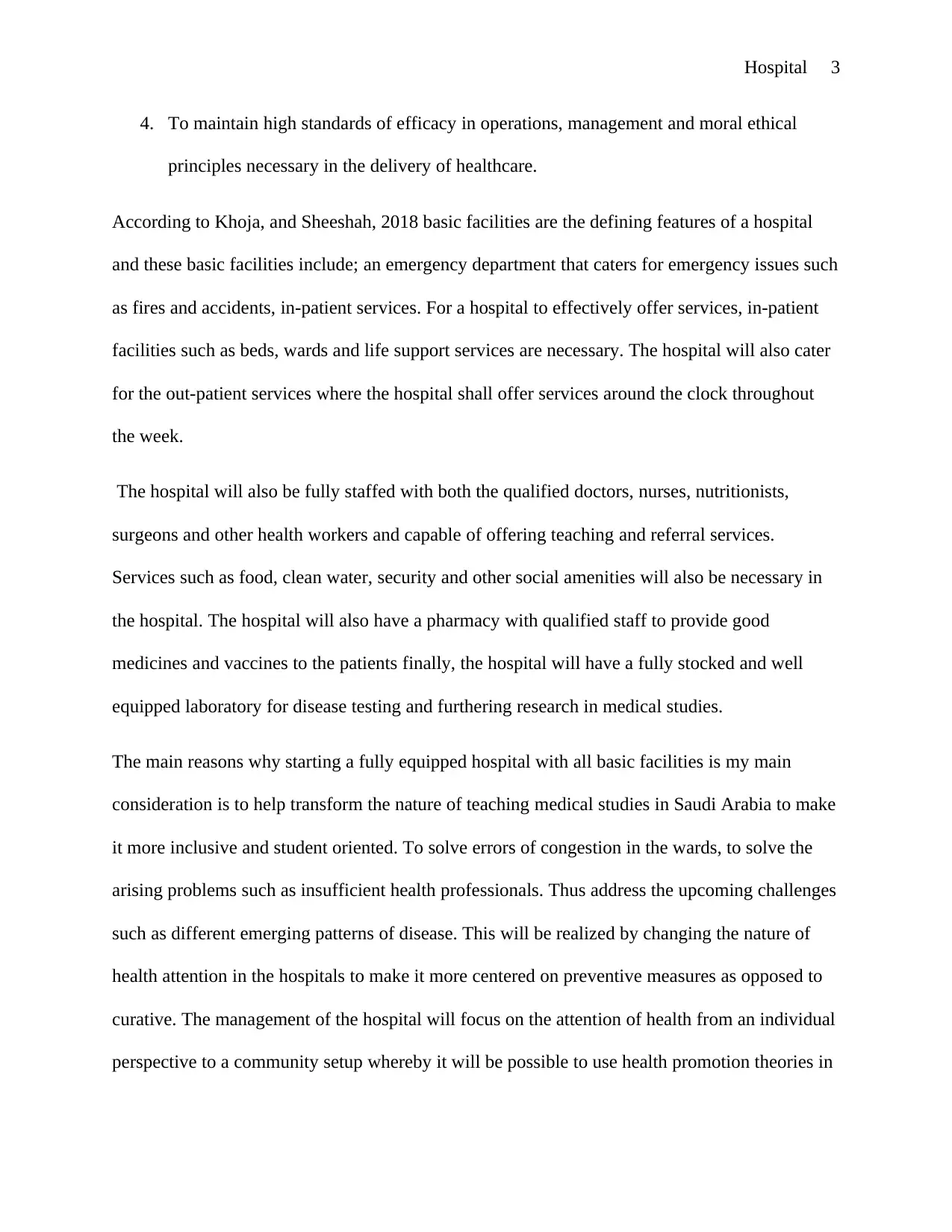
Hospital 3
4. To maintain high standards of efficacy in operations, management and moral ethical
principles necessary in the delivery of healthcare.
According to Khoja, and Sheeshah, 2018 basic facilities are the defining features of a hospital
and these basic facilities include; an emergency department that caters for emergency issues such
as fires and accidents, in-patient services. For a hospital to effectively offer services, in-patient
facilities such as beds, wards and life support services are necessary. The hospital will also cater
for the out-patient services where the hospital shall offer services around the clock throughout
the week.
The hospital will also be fully staffed with both the qualified doctors, nurses, nutritionists,
surgeons and other health workers and capable of offering teaching and referral services.
Services such as food, clean water, security and other social amenities will also be necessary in
the hospital. The hospital will also have a pharmacy with qualified staff to provide good
medicines and vaccines to the patients finally, the hospital will have a fully stocked and well
equipped laboratory for disease testing and furthering research in medical studies.
The main reasons why starting a fully equipped hospital with all basic facilities is my main
consideration is to help transform the nature of teaching medical studies in Saudi Arabia to make
it more inclusive and student oriented. To solve errors of congestion in the wards, to solve the
arising problems such as insufficient health professionals. Thus address the upcoming challenges
such as different emerging patterns of disease. This will be realized by changing the nature of
health attention in the hospitals to make it more centered on preventive measures as opposed to
curative. The management of the hospital will focus on the attention of health from an individual
perspective to a community setup whereby it will be possible to use health promotion theories in
4. To maintain high standards of efficacy in operations, management and moral ethical
principles necessary in the delivery of healthcare.
According to Khoja, and Sheeshah, 2018 basic facilities are the defining features of a hospital
and these basic facilities include; an emergency department that caters for emergency issues such
as fires and accidents, in-patient services. For a hospital to effectively offer services, in-patient
facilities such as beds, wards and life support services are necessary. The hospital will also cater
for the out-patient services where the hospital shall offer services around the clock throughout
the week.
The hospital will also be fully staffed with both the qualified doctors, nurses, nutritionists,
surgeons and other health workers and capable of offering teaching and referral services.
Services such as food, clean water, security and other social amenities will also be necessary in
the hospital. The hospital will also have a pharmacy with qualified staff to provide good
medicines and vaccines to the patients finally, the hospital will have a fully stocked and well
equipped laboratory for disease testing and furthering research in medical studies.
The main reasons why starting a fully equipped hospital with all basic facilities is my main
consideration is to help transform the nature of teaching medical studies in Saudi Arabia to make
it more inclusive and student oriented. To solve errors of congestion in the wards, to solve the
arising problems such as insufficient health professionals. Thus address the upcoming challenges
such as different emerging patterns of disease. This will be realized by changing the nature of
health attention in the hospitals to make it more centered on preventive measures as opposed to
curative. The management of the hospital will focus on the attention of health from an individual
perspective to a community setup whereby it will be possible to use health promotion theories in
⊘ This is a preview!⊘
Do you want full access?
Subscribe today to unlock all pages.

Trusted by 1+ million students worldwide

Hospital 4
disease prevalence control, and resolving the pharmacological burden in the Saudi Arabian
populations.
Project rationale
The main problem that led me to choosing a hospital well equipped with basic facilities as my
project is to help improve the condition and nature of health services in Saudi Arabia by setting
an example in the health sector. The hospitals are faced with numerous challenges some ranging
from mismanagement of finances, incompetent staff, poor teaching facilities among other
problems. The project is therefore set to address these challenges not necessary charged with the
responsibility of solving these challenges but to try and bridge the gap between the services
offered by the private sector and those of the government through prices subsidy, quality
assurance and competency in management.
The hospital is set not a complete solution to all the existing problems but some standard
measure of which other hospitals are expected to arrive, maintain and operate at.by setting these
standards, the hospital will then influence the other hospital managers and policy makers in
improving the condition of health services in Saudi Arabia. I arrived at the decision of setting up
a hospital with all basic facilities after assessing a series of considerations such as ethical
considerations and legal frameworks in the Saudi Arabian health management. Looking at the
existing social patterns of community health ways in which all these challenges can be addressed
through collaborative efforts between the society and the government.
For instance, explains Berkman, et al 2014 all health services are regulated by the government
through the ministry of health. Public hospitals enjoy government funding and are thus able to
provide services at relatively cheaper rates. However, these government funded institutions are
disease prevalence control, and resolving the pharmacological burden in the Saudi Arabian
populations.
Project rationale
The main problem that led me to choosing a hospital well equipped with basic facilities as my
project is to help improve the condition and nature of health services in Saudi Arabia by setting
an example in the health sector. The hospitals are faced with numerous challenges some ranging
from mismanagement of finances, incompetent staff, poor teaching facilities among other
problems. The project is therefore set to address these challenges not necessary charged with the
responsibility of solving these challenges but to try and bridge the gap between the services
offered by the private sector and those of the government through prices subsidy, quality
assurance and competency in management.
The hospital is set not a complete solution to all the existing problems but some standard
measure of which other hospitals are expected to arrive, maintain and operate at.by setting these
standards, the hospital will then influence the other hospital managers and policy makers in
improving the condition of health services in Saudi Arabia. I arrived at the decision of setting up
a hospital with all basic facilities after assessing a series of considerations such as ethical
considerations and legal frameworks in the Saudi Arabian health management. Looking at the
existing social patterns of community health ways in which all these challenges can be addressed
through collaborative efforts between the society and the government.
For instance, explains Berkman, et al 2014 all health services are regulated by the government
through the ministry of health. Public hospitals enjoy government funding and are thus able to
provide services at relatively cheaper rates. However, these government funded institutions are
Paraphrase This Document
Need a fresh take? Get an instant paraphrase of this document with our AI Paraphraser
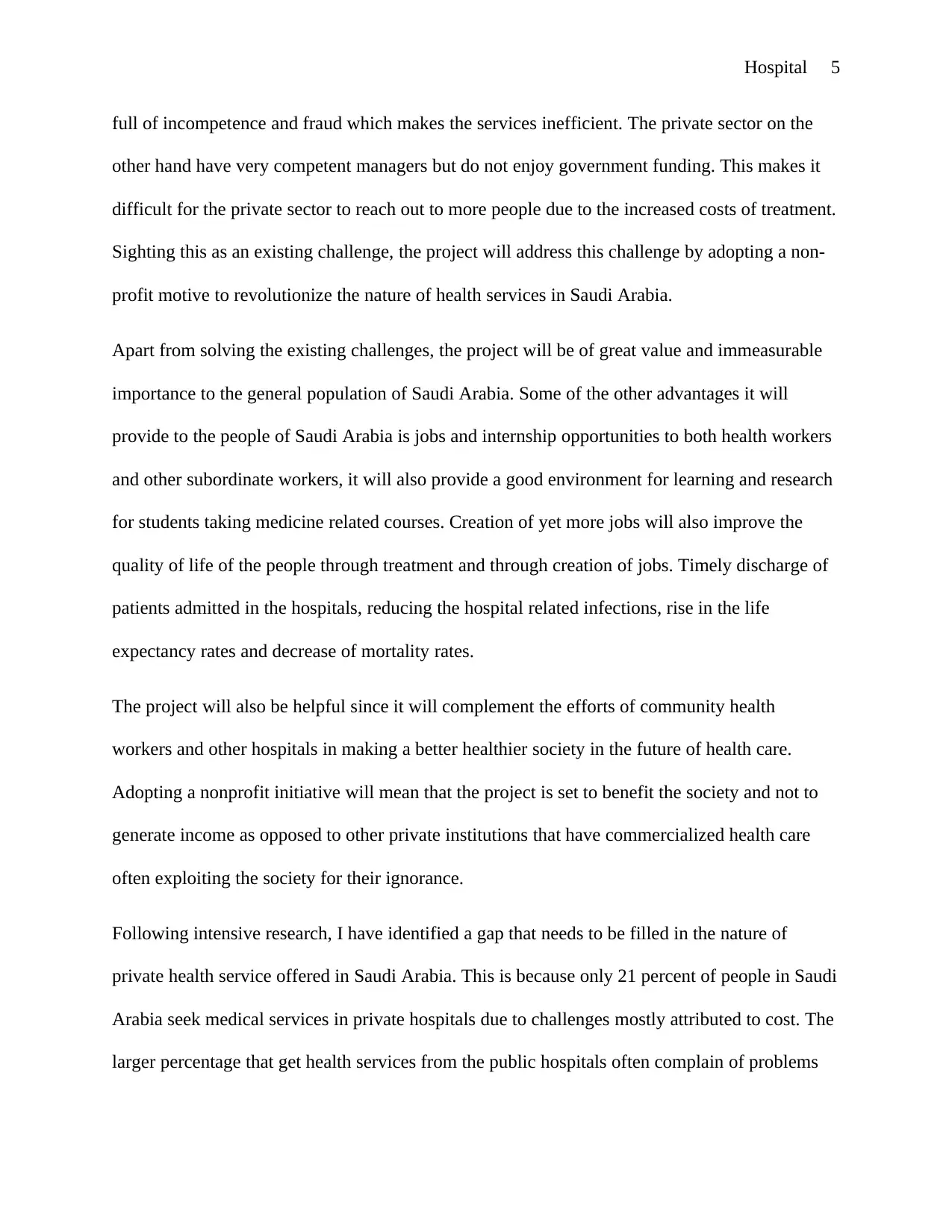
Hospital 5
full of incompetence and fraud which makes the services inefficient. The private sector on the
other hand have very competent managers but do not enjoy government funding. This makes it
difficult for the private sector to reach out to more people due to the increased costs of treatment.
Sighting this as an existing challenge, the project will address this challenge by adopting a non-
profit motive to revolutionize the nature of health services in Saudi Arabia.
Apart from solving the existing challenges, the project will be of great value and immeasurable
importance to the general population of Saudi Arabia. Some of the other advantages it will
provide to the people of Saudi Arabia is jobs and internship opportunities to both health workers
and other subordinate workers, it will also provide a good environment for learning and research
for students taking medicine related courses. Creation of yet more jobs will also improve the
quality of life of the people through treatment and through creation of jobs. Timely discharge of
patients admitted in the hospitals, reducing the hospital related infections, rise in the life
expectancy rates and decrease of mortality rates.
The project will also be helpful since it will complement the efforts of community health
workers and other hospitals in making a better healthier society in the future of health care.
Adopting a nonprofit initiative will mean that the project is set to benefit the society and not to
generate income as opposed to other private institutions that have commercialized health care
often exploiting the society for their ignorance.
Following intensive research, I have identified a gap that needs to be filled in the nature of
private health service offered in Saudi Arabia. This is because only 21 percent of people in Saudi
Arabia seek medical services in private hospitals due to challenges mostly attributed to cost. The
larger percentage that get health services from the public hospitals often complain of problems
full of incompetence and fraud which makes the services inefficient. The private sector on the
other hand have very competent managers but do not enjoy government funding. This makes it
difficult for the private sector to reach out to more people due to the increased costs of treatment.
Sighting this as an existing challenge, the project will address this challenge by adopting a non-
profit motive to revolutionize the nature of health services in Saudi Arabia.
Apart from solving the existing challenges, the project will be of great value and immeasurable
importance to the general population of Saudi Arabia. Some of the other advantages it will
provide to the people of Saudi Arabia is jobs and internship opportunities to both health workers
and other subordinate workers, it will also provide a good environment for learning and research
for students taking medicine related courses. Creation of yet more jobs will also improve the
quality of life of the people through treatment and through creation of jobs. Timely discharge of
patients admitted in the hospitals, reducing the hospital related infections, rise in the life
expectancy rates and decrease of mortality rates.
The project will also be helpful since it will complement the efforts of community health
workers and other hospitals in making a better healthier society in the future of health care.
Adopting a nonprofit initiative will mean that the project is set to benefit the society and not to
generate income as opposed to other private institutions that have commercialized health care
often exploiting the society for their ignorance.
Following intensive research, I have identified a gap that needs to be filled in the nature of
private health service offered in Saudi Arabia. This is because only 21 percent of people in Saudi
Arabia seek medical services in private hospitals due to challenges mostly attributed to cost. The
larger percentage that get health services from the public hospitals often complain of problems

Hospital 6
associated with bureaucracy within the hospital setting, poor quality of services and
overcrowding in both the in-patient and out-patient facilities.
Fischer, et al 2016 continues to address the same by arguing that unfortunately, among the 21
percent, few people seek specialized treatment in hospitals. The majority of this 21 percent is
formed by people who go to clinics and checkups or laboratories to supplement the health
services they receive in the public hospitals. Minimizing the cost in the private sector could
therefore mean that more people will access services in the private sector at ease. Similarly,
improvement of the services in the public sector will also ensure that the community health
services have more advantages to the people and due to the demand supply curve, the private
institutions will have no left alternative but to subsidize costs.
Project objectives and strategies
The project objectives and strategies have been well assessed to meet the criterion of the five
qualities of goals and objectives which are specific, measurable, achievable, time bound and
realistic. They are objectives that help to improve the quality of services in a hospital and are
applicable in almost every hospital setting. They are the missing links between the existing
incompetence and the expected outcomes from the implementation of the project. The project’s
strategies have also been centered on minimizing cost and maximizing the quality to achieve
technical efficiency in the operation of the hospital.
The main objectives will be centered on the improvement of services and the quality of medical
services offered in the hospital. For instance, the hospital will formulate policies that are
consistent with those from the recommendation of Robert wood Johnson Foundation initiative on
the future of nursing in the United States. This will include formulation of policies that will favor
associated with bureaucracy within the hospital setting, poor quality of services and
overcrowding in both the in-patient and out-patient facilities.
Fischer, et al 2016 continues to address the same by arguing that unfortunately, among the 21
percent, few people seek specialized treatment in hospitals. The majority of this 21 percent is
formed by people who go to clinics and checkups or laboratories to supplement the health
services they receive in the public hospitals. Minimizing the cost in the private sector could
therefore mean that more people will access services in the private sector at ease. Similarly,
improvement of the services in the public sector will also ensure that the community health
services have more advantages to the people and due to the demand supply curve, the private
institutions will have no left alternative but to subsidize costs.
Project objectives and strategies
The project objectives and strategies have been well assessed to meet the criterion of the five
qualities of goals and objectives which are specific, measurable, achievable, time bound and
realistic. They are objectives that help to improve the quality of services in a hospital and are
applicable in almost every hospital setting. They are the missing links between the existing
incompetence and the expected outcomes from the implementation of the project. The project’s
strategies have also been centered on minimizing cost and maximizing the quality to achieve
technical efficiency in the operation of the hospital.
The main objectives will be centered on the improvement of services and the quality of medical
services offered in the hospital. For instance, the hospital will formulate policies that are
consistent with those from the recommendation of Robert wood Johnson Foundation initiative on
the future of nursing in the United States. This will include formulation of policies that will favor
⊘ This is a preview!⊘
Do you want full access?
Subscribe today to unlock all pages.

Trusted by 1+ million students worldwide
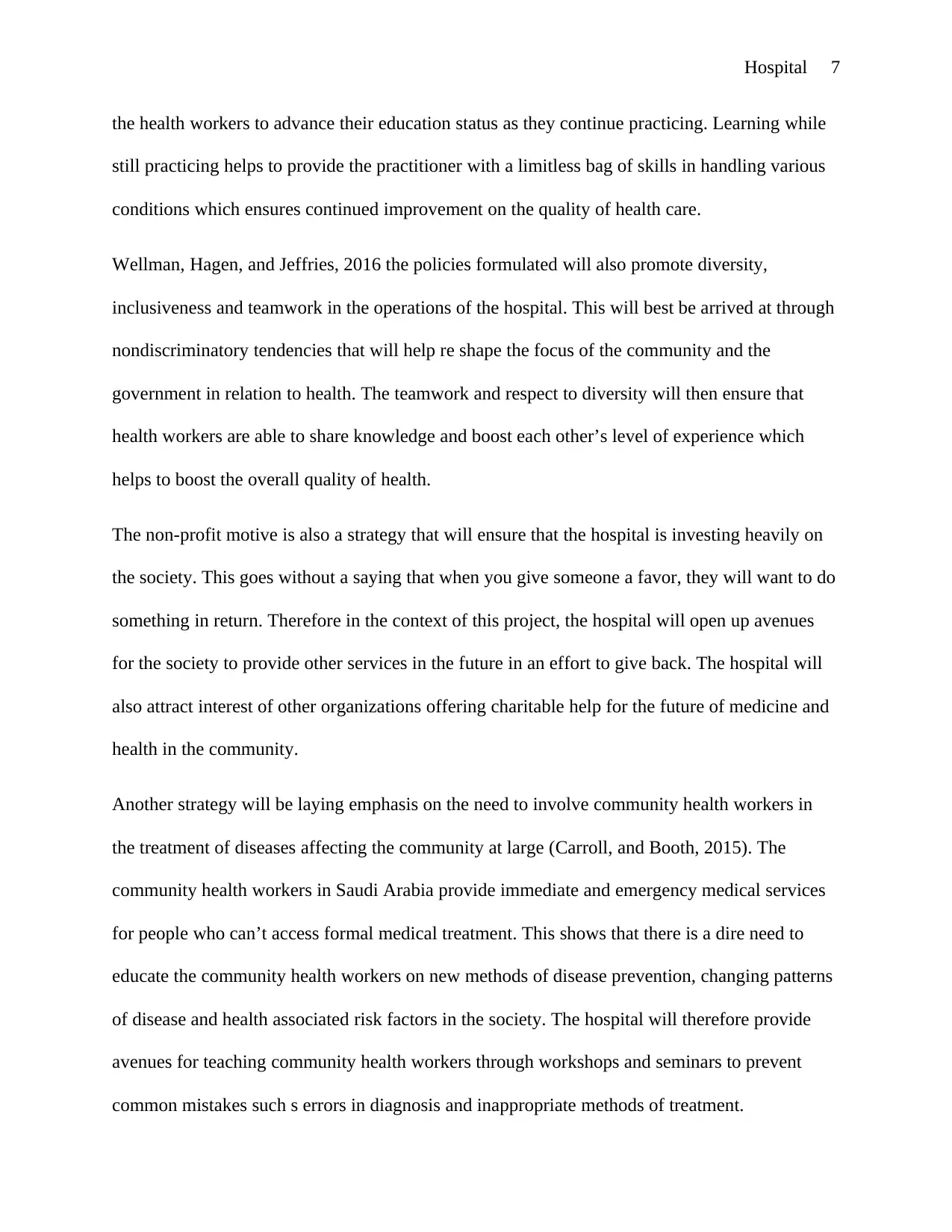
Hospital 7
the health workers to advance their education status as they continue practicing. Learning while
still practicing helps to provide the practitioner with a limitless bag of skills in handling various
conditions which ensures continued improvement on the quality of health care.
Wellman, Hagen, and Jeffries, 2016 the policies formulated will also promote diversity,
inclusiveness and teamwork in the operations of the hospital. This will best be arrived at through
nondiscriminatory tendencies that will help re shape the focus of the community and the
government in relation to health. The teamwork and respect to diversity will then ensure that
health workers are able to share knowledge and boost each other’s level of experience which
helps to boost the overall quality of health.
The non-profit motive is also a strategy that will ensure that the hospital is investing heavily on
the society. This goes without a saying that when you give someone a favor, they will want to do
something in return. Therefore in the context of this project, the hospital will open up avenues
for the society to provide other services in the future in an effort to give back. The hospital will
also attract interest of other organizations offering charitable help for the future of medicine and
health in the community.
Another strategy will be laying emphasis on the need to involve community health workers in
the treatment of diseases affecting the community at large (Carroll, and Booth, 2015). The
community health workers in Saudi Arabia provide immediate and emergency medical services
for people who can’t access formal medical treatment. This shows that there is a dire need to
educate the community health workers on new methods of disease prevention, changing patterns
of disease and health associated risk factors in the society. The hospital will therefore provide
avenues for teaching community health workers through workshops and seminars to prevent
common mistakes such s errors in diagnosis and inappropriate methods of treatment.
the health workers to advance their education status as they continue practicing. Learning while
still practicing helps to provide the practitioner with a limitless bag of skills in handling various
conditions which ensures continued improvement on the quality of health care.
Wellman, Hagen, and Jeffries, 2016 the policies formulated will also promote diversity,
inclusiveness and teamwork in the operations of the hospital. This will best be arrived at through
nondiscriminatory tendencies that will help re shape the focus of the community and the
government in relation to health. The teamwork and respect to diversity will then ensure that
health workers are able to share knowledge and boost each other’s level of experience which
helps to boost the overall quality of health.
The non-profit motive is also a strategy that will ensure that the hospital is investing heavily on
the society. This goes without a saying that when you give someone a favor, they will want to do
something in return. Therefore in the context of this project, the hospital will open up avenues
for the society to provide other services in the future in an effort to give back. The hospital will
also attract interest of other organizations offering charitable help for the future of medicine and
health in the community.
Another strategy will be laying emphasis on the need to involve community health workers in
the treatment of diseases affecting the community at large (Carroll, and Booth, 2015). The
community health workers in Saudi Arabia provide immediate and emergency medical services
for people who can’t access formal medical treatment. This shows that there is a dire need to
educate the community health workers on new methods of disease prevention, changing patterns
of disease and health associated risk factors in the society. The hospital will therefore provide
avenues for teaching community health workers through workshops and seminars to prevent
common mistakes such s errors in diagnosis and inappropriate methods of treatment.
Paraphrase This Document
Need a fresh take? Get an instant paraphrase of this document with our AI Paraphraser
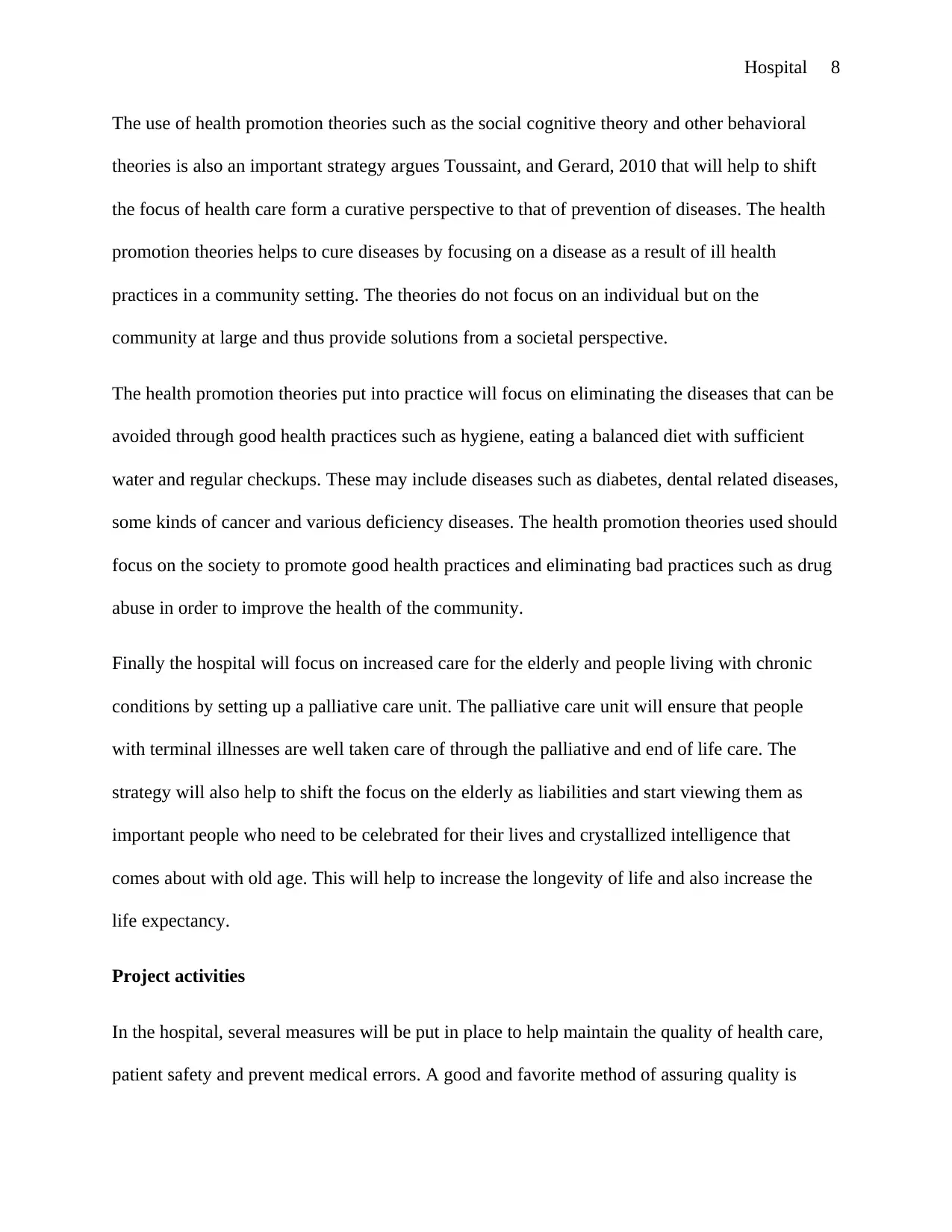
Hospital 8
The use of health promotion theories such as the social cognitive theory and other behavioral
theories is also an important strategy argues Toussaint, and Gerard, 2010 that will help to shift
the focus of health care form a curative perspective to that of prevention of diseases. The health
promotion theories helps to cure diseases by focusing on a disease as a result of ill health
practices in a community setting. The theories do not focus on an individual but on the
community at large and thus provide solutions from a societal perspective.
The health promotion theories put into practice will focus on eliminating the diseases that can be
avoided through good health practices such as hygiene, eating a balanced diet with sufficient
water and regular checkups. These may include diseases such as diabetes, dental related diseases,
some kinds of cancer and various deficiency diseases. The health promotion theories used should
focus on the society to promote good health practices and eliminating bad practices such as drug
abuse in order to improve the health of the community.
Finally the hospital will focus on increased care for the elderly and people living with chronic
conditions by setting up a palliative care unit. The palliative care unit will ensure that people
with terminal illnesses are well taken care of through the palliative and end of life care. The
strategy will also help to shift the focus on the elderly as liabilities and start viewing them as
important people who need to be celebrated for their lives and crystallized intelligence that
comes about with old age. This will help to increase the longevity of life and also increase the
life expectancy.
Project activities
In the hospital, several measures will be put in place to help maintain the quality of health care,
patient safety and prevent medical errors. A good and favorite method of assuring quality is
The use of health promotion theories such as the social cognitive theory and other behavioral
theories is also an important strategy argues Toussaint, and Gerard, 2010 that will help to shift
the focus of health care form a curative perspective to that of prevention of diseases. The health
promotion theories helps to cure diseases by focusing on a disease as a result of ill health
practices in a community setting. The theories do not focus on an individual but on the
community at large and thus provide solutions from a societal perspective.
The health promotion theories put into practice will focus on eliminating the diseases that can be
avoided through good health practices such as hygiene, eating a balanced diet with sufficient
water and regular checkups. These may include diseases such as diabetes, dental related diseases,
some kinds of cancer and various deficiency diseases. The health promotion theories used should
focus on the society to promote good health practices and eliminating bad practices such as drug
abuse in order to improve the health of the community.
Finally the hospital will focus on increased care for the elderly and people living with chronic
conditions by setting up a palliative care unit. The palliative care unit will ensure that people
with terminal illnesses are well taken care of through the palliative and end of life care. The
strategy will also help to shift the focus on the elderly as liabilities and start viewing them as
important people who need to be celebrated for their lives and crystallized intelligence that
comes about with old age. This will help to increase the longevity of life and also increase the
life expectancy.
Project activities
In the hospital, several measures will be put in place to help maintain the quality of health care,
patient safety and prevent medical errors. A good and favorite method of assuring quality is
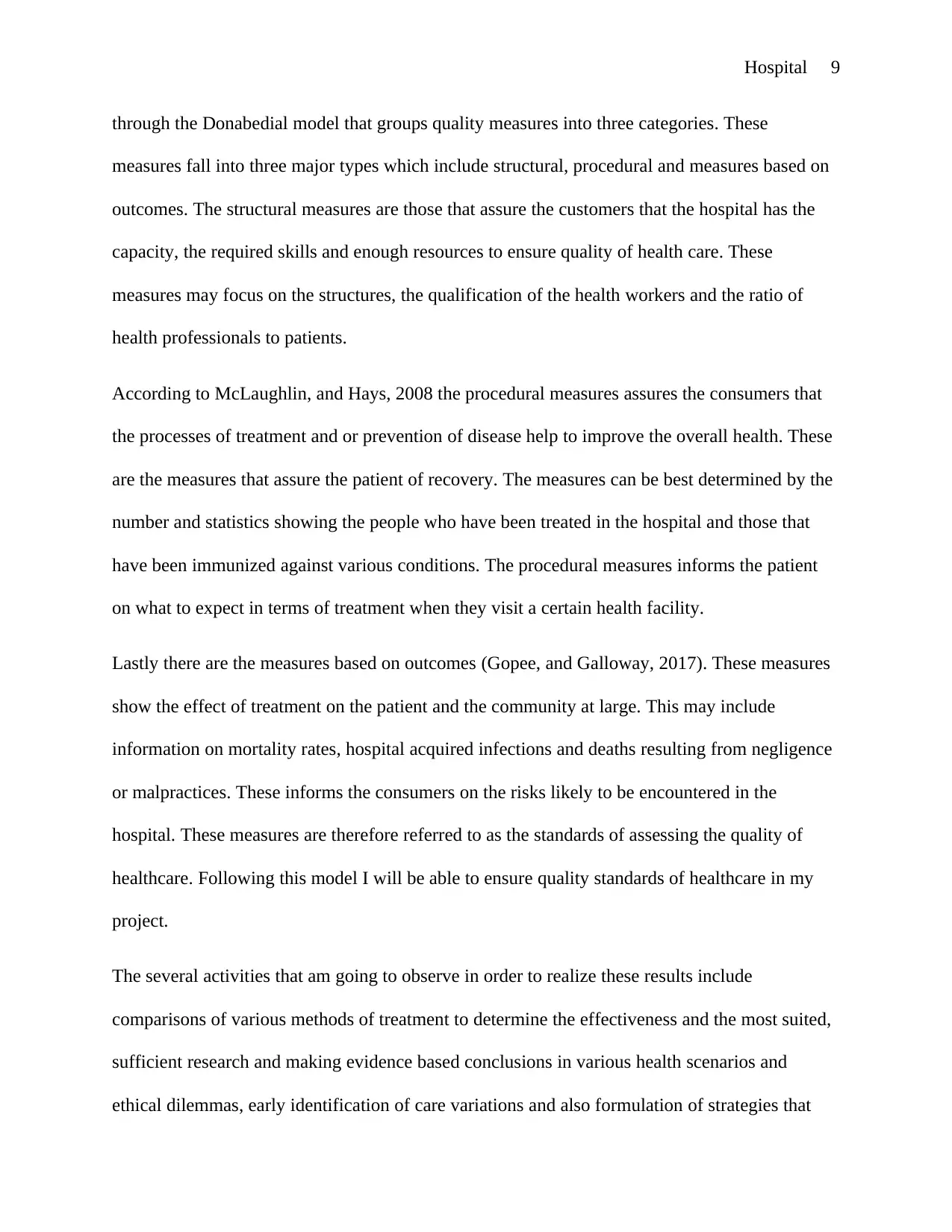
Hospital 9
through the Donabedial model that groups quality measures into three categories. These
measures fall into three major types which include structural, procedural and measures based on
outcomes. The structural measures are those that assure the customers that the hospital has the
capacity, the required skills and enough resources to ensure quality of health care. These
measures may focus on the structures, the qualification of the health workers and the ratio of
health professionals to patients.
According to McLaughlin, and Hays, 2008 the procedural measures assures the consumers that
the processes of treatment and or prevention of disease help to improve the overall health. These
are the measures that assure the patient of recovery. The measures can be best determined by the
number and statistics showing the people who have been treated in the hospital and those that
have been immunized against various conditions. The procedural measures informs the patient
on what to expect in terms of treatment when they visit a certain health facility.
Lastly there are the measures based on outcomes (Gopee, and Galloway, 2017). These measures
show the effect of treatment on the patient and the community at large. This may include
information on mortality rates, hospital acquired infections and deaths resulting from negligence
or malpractices. These informs the consumers on the risks likely to be encountered in the
hospital. These measures are therefore referred to as the standards of assessing the quality of
healthcare. Following this model I will be able to ensure quality standards of healthcare in my
project.
The several activities that am going to observe in order to realize these results include
comparisons of various methods of treatment to determine the effectiveness and the most suited,
sufficient research and making evidence based conclusions in various health scenarios and
ethical dilemmas, early identification of care variations and also formulation of strategies that
through the Donabedial model that groups quality measures into three categories. These
measures fall into three major types which include structural, procedural and measures based on
outcomes. The structural measures are those that assure the customers that the hospital has the
capacity, the required skills and enough resources to ensure quality of health care. These
measures may focus on the structures, the qualification of the health workers and the ratio of
health professionals to patients.
According to McLaughlin, and Hays, 2008 the procedural measures assures the consumers that
the processes of treatment and or prevention of disease help to improve the overall health. These
are the measures that assure the patient of recovery. The measures can be best determined by the
number and statistics showing the people who have been treated in the hospital and those that
have been immunized against various conditions. The procedural measures informs the patient
on what to expect in terms of treatment when they visit a certain health facility.
Lastly there are the measures based on outcomes (Gopee, and Galloway, 2017). These measures
show the effect of treatment on the patient and the community at large. This may include
information on mortality rates, hospital acquired infections and deaths resulting from negligence
or malpractices. These informs the consumers on the risks likely to be encountered in the
hospital. These measures are therefore referred to as the standards of assessing the quality of
healthcare. Following this model I will be able to ensure quality standards of healthcare in my
project.
The several activities that am going to observe in order to realize these results include
comparisons of various methods of treatment to determine the effectiveness and the most suited,
sufficient research and making evidence based conclusions in various health scenarios and
ethical dilemmas, early identification of care variations and also formulation of strategies that
⊘ This is a preview!⊘
Do you want full access?
Subscribe today to unlock all pages.

Trusted by 1+ million students worldwide

Hospital 10
could help to improve the quality of care. In addition, I’ll see to it that the hospital conducts a
SWOT analysis regularly and focuses on interventions to strengthen the weak areas. Involving
consumers could be one step towards ensuring that these standards are met.
Management
The quality of leadership always plays a key role in the success of any institution. The
management is the most essential part of an organization. The success or failure of any
organization is depended on the leadership and the management. Focusing on the tremendous
success I expect to realize in my project, I have researched on various leadership styles and
management techniques that will help me realize the quality of leadership required in healthcare.
The management will employ several techniques and leadership styles to achieve the required
quality of leadership. The POSDCORB technique of management outlined by Luther Gulick and
Lyndal Urwick in the classical organizational theory is great tool that I will use in management. I
will use the tool because all the elements in the POSDCORB are necessary to achieve the
required success. These elements include planning, organizing, staffing, directing, coordinating,
reporting and budgeting. These elements describe the various ways that management work can
be broken down into to ease the work of the overall head.
The use of the Henry Fayol principles of management is also necessary in breaking down the
management work among the managers (Grunden, 2008). To begin with, division of work is
necessary since it ensures that individuals do the work that they can do best. This not only makes
work easier but it also saves on time since it allows for specialization. In authority and
responsibility, it is necessary to put all offices under a superior supervisor in the hierarchy of
could help to improve the quality of care. In addition, I’ll see to it that the hospital conducts a
SWOT analysis regularly and focuses on interventions to strengthen the weak areas. Involving
consumers could be one step towards ensuring that these standards are met.
Management
The quality of leadership always plays a key role in the success of any institution. The
management is the most essential part of an organization. The success or failure of any
organization is depended on the leadership and the management. Focusing on the tremendous
success I expect to realize in my project, I have researched on various leadership styles and
management techniques that will help me realize the quality of leadership required in healthcare.
The management will employ several techniques and leadership styles to achieve the required
quality of leadership. The POSDCORB technique of management outlined by Luther Gulick and
Lyndal Urwick in the classical organizational theory is great tool that I will use in management. I
will use the tool because all the elements in the POSDCORB are necessary to achieve the
required success. These elements include planning, organizing, staffing, directing, coordinating,
reporting and budgeting. These elements describe the various ways that management work can
be broken down into to ease the work of the overall head.
The use of the Henry Fayol principles of management is also necessary in breaking down the
management work among the managers (Grunden, 2008). To begin with, division of work is
necessary since it ensures that individuals do the work that they can do best. This not only makes
work easier but it also saves on time since it allows for specialization. In authority and
responsibility, it is necessary to put all offices under a superior supervisor in the hierarchy of
Paraphrase This Document
Need a fresh take? Get an instant paraphrase of this document with our AI Paraphraser

Hospital 11
organization and accord the supervisor’s legislative authority so as to ensure the subordinates
develop discipline and hard work in their roles.
Thomas, 2015 explains that the unity of command and direction is another principle that will be
intersected at the heart of the organization. This will in turn ensure that workers have one
authority and one objective which is to achieve the goals of the hospital. By so doing, all the
workers’ efforts will be geared towards realizing the common goals of the hospital. It would
insufficient to exit on the principles without discussing remuneration f staff and equity. With
regard to remuneration, the staff’s salaries should be good and allowances in order to make them
give the best to the success of the hospital. The workers should also be treated equally, justly and
fairly but they should also have in mind the principle of subordination of personal interests to
those of the hospital. Finally, the esprit de corps principle shall be used to promote oneness and
high level of hard work among the workers to ensure that the hospital shall always have a
hardworking pool of workers.
Lastly, rewarding of outstanding and hardworking workers will be a management strategy to
encourage the workers to work hard and to promote the objectives and interests of the hospital at
heart (Kenney, 2011). This will encourage to workers too to employ the tools of transformation
in their interaction with patients and other workers and to practice moral courage following the
examples of rewarded workers. The rewarding of workers will also help to set the standards at
which the health services are expected to be provided by the workers.
The leadership techniques adopted in the hospital will range from transformational leadership to
delegative leadership depending on the situation at hand. Delegative leadership will help the
leadership process by making the workers feel that they run the activities of the hospital which
will increase a sense of collective responsibility with the workers. The workers will then be keen
organization and accord the supervisor’s legislative authority so as to ensure the subordinates
develop discipline and hard work in their roles.
Thomas, 2015 explains that the unity of command and direction is another principle that will be
intersected at the heart of the organization. This will in turn ensure that workers have one
authority and one objective which is to achieve the goals of the hospital. By so doing, all the
workers’ efforts will be geared towards realizing the common goals of the hospital. It would
insufficient to exit on the principles without discussing remuneration f staff and equity. With
regard to remuneration, the staff’s salaries should be good and allowances in order to make them
give the best to the success of the hospital. The workers should also be treated equally, justly and
fairly but they should also have in mind the principle of subordination of personal interests to
those of the hospital. Finally, the esprit de corps principle shall be used to promote oneness and
high level of hard work among the workers to ensure that the hospital shall always have a
hardworking pool of workers.
Lastly, rewarding of outstanding and hardworking workers will be a management strategy to
encourage the workers to work hard and to promote the objectives and interests of the hospital at
heart (Kenney, 2011). This will encourage to workers too to employ the tools of transformation
in their interaction with patients and other workers and to practice moral courage following the
examples of rewarded workers. The rewarding of workers will also help to set the standards at
which the health services are expected to be provided by the workers.
The leadership techniques adopted in the hospital will range from transformational leadership to
delegative leadership depending on the situation at hand. Delegative leadership will help the
leadership process by making the workers feel that they run the activities of the hospital which
will increase a sense of collective responsibility with the workers. The workers will then be keen
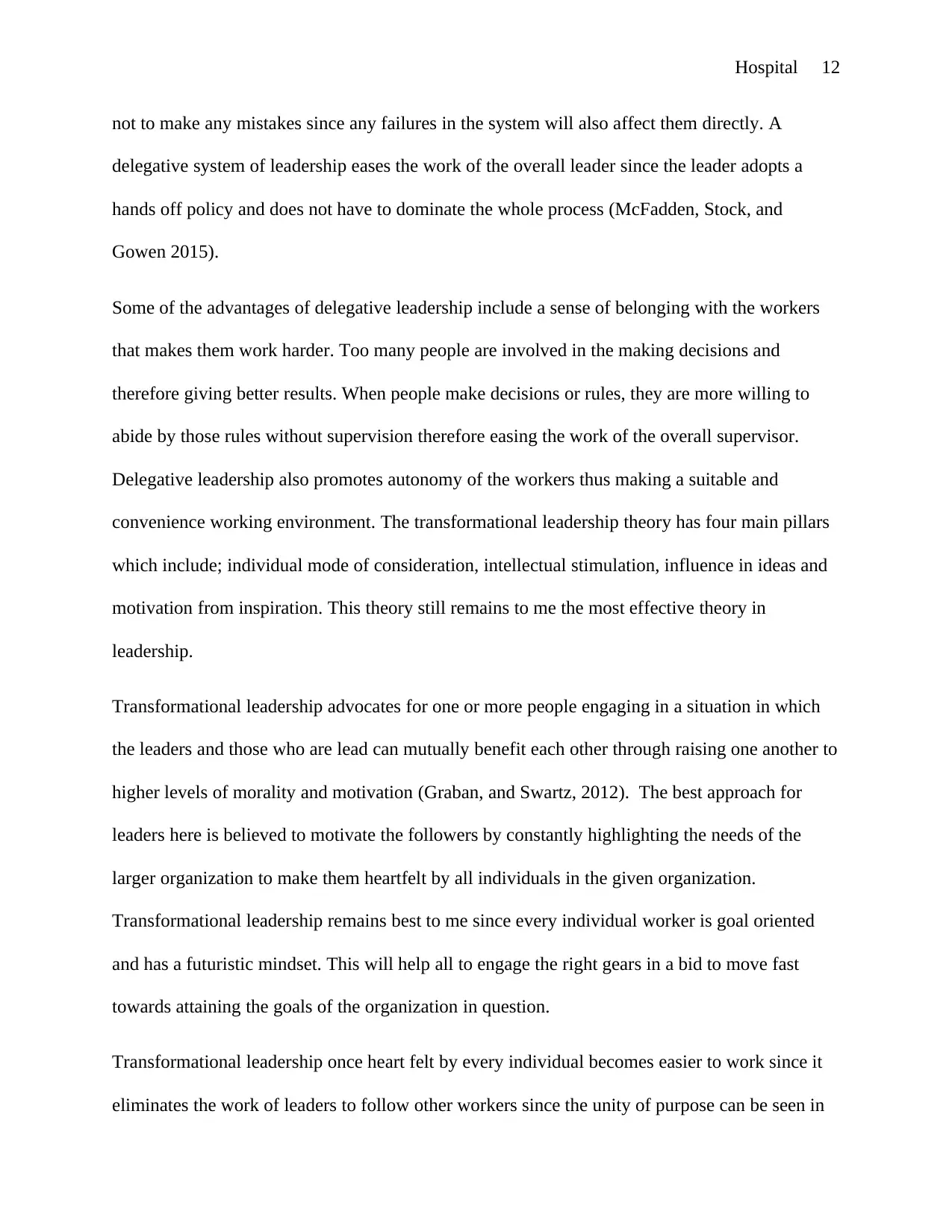
Hospital 12
not to make any mistakes since any failures in the system will also affect them directly. A
delegative system of leadership eases the work of the overall leader since the leader adopts a
hands off policy and does not have to dominate the whole process (McFadden, Stock, and
Gowen 2015).
Some of the advantages of delegative leadership include a sense of belonging with the workers
that makes them work harder. Too many people are involved in the making decisions and
therefore giving better results. When people make decisions or rules, they are more willing to
abide by those rules without supervision therefore easing the work of the overall supervisor.
Delegative leadership also promotes autonomy of the workers thus making a suitable and
convenience working environment. The transformational leadership theory has four main pillars
which include; individual mode of consideration, intellectual stimulation, influence in ideas and
motivation from inspiration. This theory still remains to me the most effective theory in
leadership.
Transformational leadership advocates for one or more people engaging in a situation in which
the leaders and those who are lead can mutually benefit each other through raising one another to
higher levels of morality and motivation (Graban, and Swartz, 2012). The best approach for
leaders here is believed to motivate the followers by constantly highlighting the needs of the
larger organization to make them heartfelt by all individuals in the given organization.
Transformational leadership remains best to me since every individual worker is goal oriented
and has a futuristic mindset. This will help all to engage the right gears in a bid to move fast
towards attaining the goals of the organization in question.
Transformational leadership once heart felt by every individual becomes easier to work since it
eliminates the work of leaders to follow other workers since the unity of purpose can be seen in
not to make any mistakes since any failures in the system will also affect them directly. A
delegative system of leadership eases the work of the overall leader since the leader adopts a
hands off policy and does not have to dominate the whole process (McFadden, Stock, and
Gowen 2015).
Some of the advantages of delegative leadership include a sense of belonging with the workers
that makes them work harder. Too many people are involved in the making decisions and
therefore giving better results. When people make decisions or rules, they are more willing to
abide by those rules without supervision therefore easing the work of the overall supervisor.
Delegative leadership also promotes autonomy of the workers thus making a suitable and
convenience working environment. The transformational leadership theory has four main pillars
which include; individual mode of consideration, intellectual stimulation, influence in ideas and
motivation from inspiration. This theory still remains to me the most effective theory in
leadership.
Transformational leadership advocates for one or more people engaging in a situation in which
the leaders and those who are lead can mutually benefit each other through raising one another to
higher levels of morality and motivation (Graban, and Swartz, 2012). The best approach for
leaders here is believed to motivate the followers by constantly highlighting the needs of the
larger organization to make them heartfelt by all individuals in the given organization.
Transformational leadership remains best to me since every individual worker is goal oriented
and has a futuristic mindset. This will help all to engage the right gears in a bid to move fast
towards attaining the goals of the organization in question.
Transformational leadership once heart felt by every individual becomes easier to work since it
eliminates the work of leaders to follow other workers since the unity of purpose can be seen in
⊘ This is a preview!⊘
Do you want full access?
Subscribe today to unlock all pages.

Trusted by 1+ million students worldwide
1 out of 18
Related Documents
Your All-in-One AI-Powered Toolkit for Academic Success.
+13062052269
info@desklib.com
Available 24*7 on WhatsApp / Email
![[object Object]](/_next/static/media/star-bottom.7253800d.svg)
Unlock your academic potential
Copyright © 2020–2025 A2Z Services. All Rights Reserved. Developed and managed by ZUCOL.





